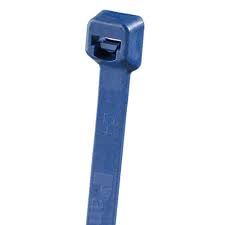Loop tensile strength measures how much force a cable tie can endure before it breaks. This rating is critical in determining whether a tie is suitable for a specific application. A tie with insufficient tensile strength may snap under stress, leading to equipment failure, safety hazards, or non-compliance with industry regulations.
Cable ties are used in a range of industries, including electrical work, automotive applications, construction, and industrial environments. Each of these settings requires a specific tensile strength to ensure that bundled cables, pipes, or other secured objects remain intact under normal and extreme conditions.
 Several organizations set guidelines to ensure cable ties meet performance and safety requirements:
Several organizations set guidelines to ensure cable ties meet performance and safety requirements:
 Tensile strength ratings indicate a tie's capacity under ideal conditions. However, real-world applications introduce variables that may impact performance.
Tensile strength ratings indicate a tie's capacity under ideal conditions. However, real-world applications introduce variables that may impact performance.
How Loop Tensile Strength Is Measured
Manufacturers test loop tensile strength under controlled conditions to ensure accuracy. The testing process involves securing a cable tie around a standard fixture and gradually applying force until it breaks. The recorded force at failure determines its loop tensile strength rating.Industry Standards for Tensile Strength Testing
 Several organizations set guidelines to ensure cable ties meet performance and safety requirements:
Several organizations set guidelines to ensure cable ties meet performance and safety requirements:
- International Electrotechnical Commission (IEC) – Defines mechanical performance standards for electrical and industrial applications.
- Military Standard (MIL-SPEC) – Establishes durability benchmarks for defense, aerospace, and mission-critical installations.
- Underwriters Laboratories (UL) – Certifies cable ties based on material strength, fire resistance, and environmental factors.
Minimum Recommended Loop Tensile Strength by Application
Cable ties are available in various tensile strengths, categorized by width, material, and design. Selecting the correct strength ensures the tie remains intact without failure.Light-Duty Applications (18–40 lbs)
Light-duty cable ties are ideal for securing small bundles in home, office, and low-stress industrial settings. Their tensile strength is suitable for organizing electrical wires, managing lightweight tubing, and securing non-critical components.- 18 lbs – Common for organizing home computer cables, desk wiring, and light-duty tubing.
- 30 lbs – Suitable for automotive wiring, small electrical installations, and light-duty bundling.
- 40 lbs – Used for minor pipe bundling, general electrical work, and temporary securing of lightweight objects.
Medium-Duty Applications (50–120 lbs)
Medium-duty ties are designed for environments that require higher tensile strength. These ties offer enhanced durability and resistance to environmental conditions such as heat, moisture, and chemicals.- 50 lbs – Commonly used in HVAC installations, automotive repairs, and structured network cabling.
- 75 lbs – Preferred for construction, warehouse bundling, and industrial electrical installations.
- 120 lbs – Required for securing large cables, plumbing components, and heavy automotive parts.
Heavy-Duty Applications (150–250 lbs)
Heavy-duty cable ties support large bundles and extreme environments. These ties are commonly used in industrial, aerospace, and defense applications where high mechanical strength is necessary.- 150 lbs – Used for industrial cable management, marine applications, and heavy machinery.
- 200 lbs – Common in aerospace, defense, and high-temperature industrial settings.
- 250 lbs – Designed for extreme loads such as securing structural components, heavy-duty equipment, and outdoor applications with high environmental stress.
Factors Affecting Loop Tensile Strength
 Tensile strength ratings indicate a tie's capacity under ideal conditions. However, real-world applications introduce variables that may impact performance.
Tensile strength ratings indicate a tie's capacity under ideal conditions. However, real-world applications introduce variables that may impact performance.
Material Composition
The material of a cable tie significantly influences its tensile strength, flexibility, and resistance to external factors.- Nylon 6/6 – The most common material, offering excellent tensile strength and resistance to chemicals and UV exposure.
- Stainless Steel – Preferred for extreme heat and corrosion resistance in industrial and marine environments.
- Flame-Retardant Nylon – Meets fire safety standards for electrical and aviation use, providing added protection in critical environments.
Environmental Conditions
Exposure to high temperatures, humidity, and harsh chemicals affects a cable tie's durability. Nylon ties, for example, can weaken under extreme heat, while prolonged UV exposure degrades untreated plastic ties. Choosing UV-resistant or weather-resistant options improves performance in outdoor applications.Proper Installation
Improper application can compromise a cable tie's effectiveness. Over-tightening can reduce flexibility and increase the risk of breakage. Always follow manufacturer guidelines to ensure correct tensioning and bundling techniques.Choosing the Right Tensile Strength
Selecting the appropriate cable tie strength involves assessing the bundle's weight, environmental exposure, and required durability. Choosing an inadequate tensile strength increases the risk of failure, while an excessively strong tie may add unnecessary cost without additional benefits.Key Considerations
- Bundle Size – Ensure the tie's length and width accommodate the full diameter of the bundle.
- Environmental Exposure – Select UV-resistant or flame-retardant ties for outdoor or high-heat applications.
- Load Requirements – Match the tensile strength rating to the maximum expected force for secure bundling.

